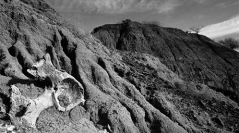

 Comptes Rendus Palevol
3 (4) - Pages 341-351
Comptes Rendus Palevol
3 (4) - Pages 341-351Decades of research at major paleoanthropological sites in eastern Africa have shown that the archaeological and paleontological resources they contain are effectively non-renewable given geomorphological and geographical constraints. The landscapes of these fossil fields were produced by centuries of erosion. Once the antiquities are collected from the lag deposits armoring the sediments, active erosion is insufficient for timely replenishment. This means that only the first few collection bouts at any given locality will be rewarded with impressive yields of fossils. The occasional exposure of better-preserved specimens from the few available actively eroding slopes will follow as yields drop. The Middle Awash project is attempting to quantify these phenomena and thereby generate information to assist in long-term site management. A cast-recapture experiment has been designed to monitor collection efficiency, and collection cycles have been instituted to monitor the rate of fossil exposure.
Paleoanthropology, Middle Awash, fossils, Aramis, Maka, geomorphology, Ethiopia